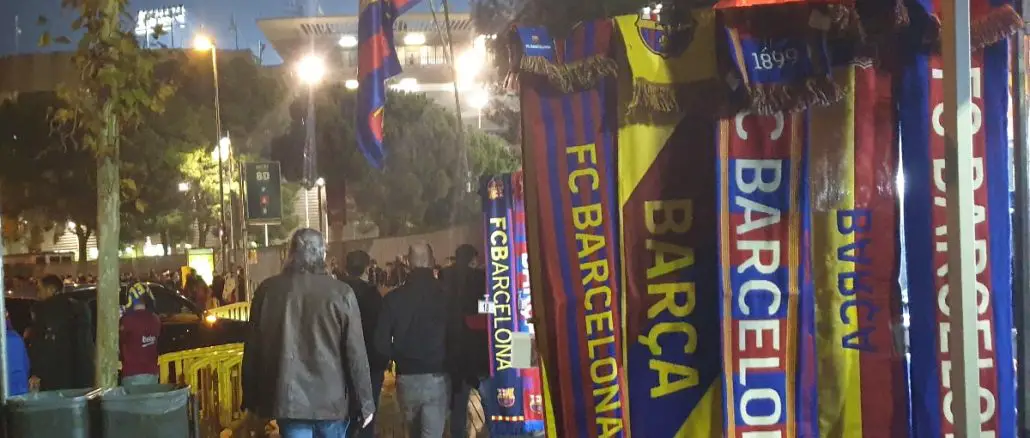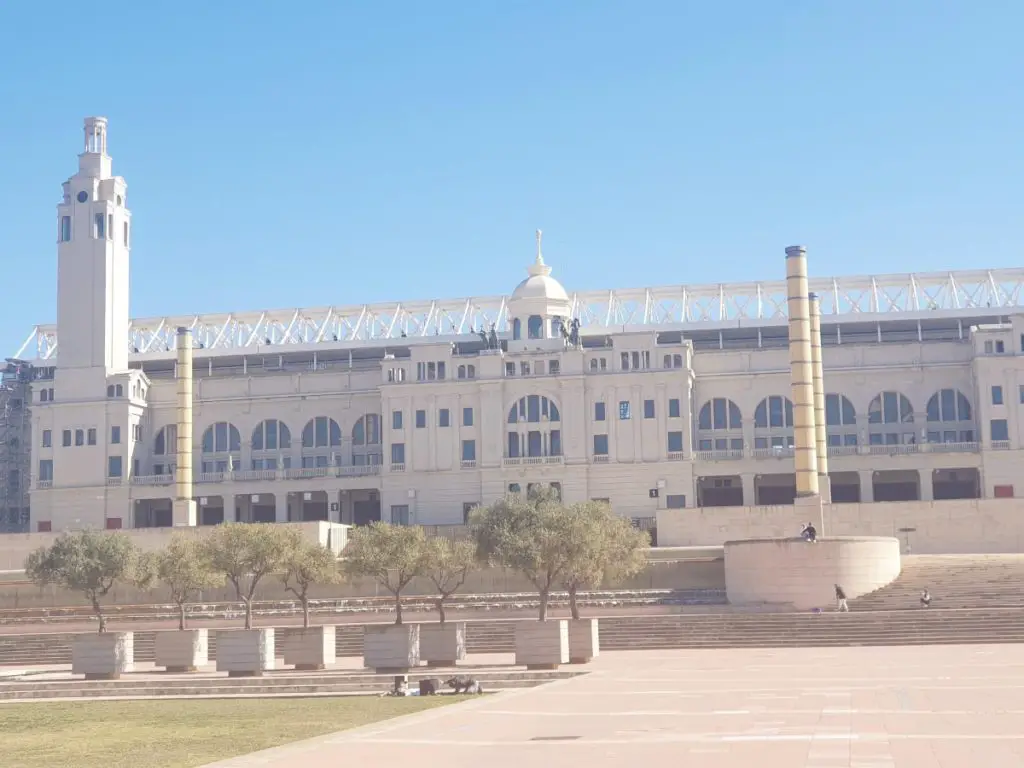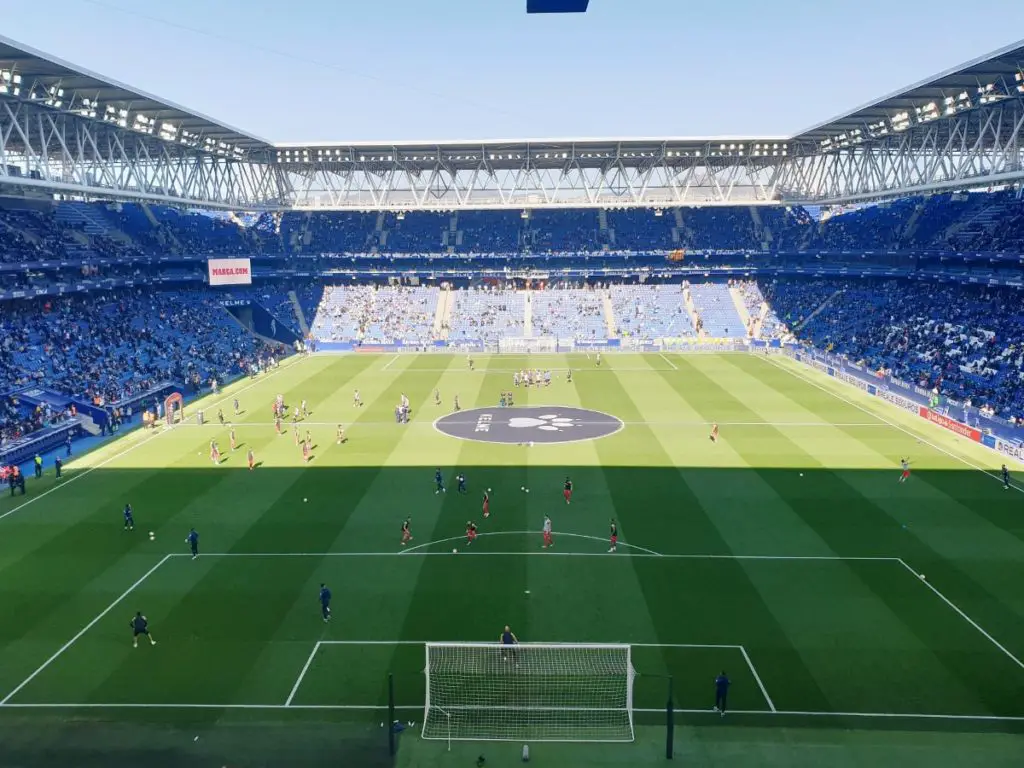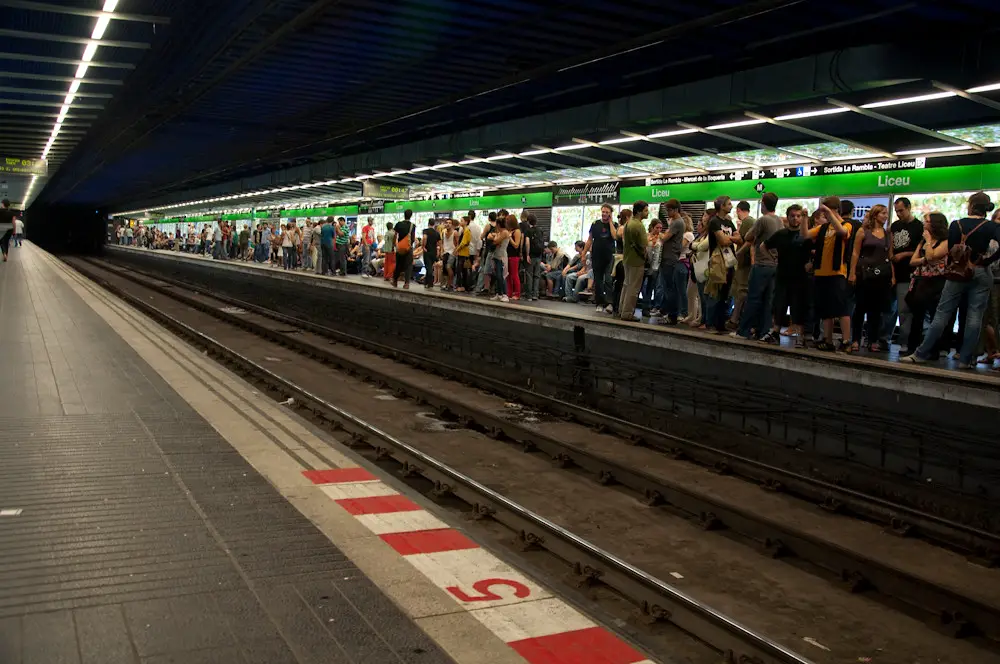
Football in Catalonia is dominated by one club with FC Barcelona having grown to become the largest symbol of Catalan identity over the decades. However anyone planning a football trip to Catalonia has plenty of options besides the standard game and stadium tour at Camp Nou, something which won’t even be possible for the foreseeable future as the club’s famous old ground undergoes a massive revamp. In this Catalonia football travel guide, we’ll also give you the lowdown on the smaller clubs across the region with tips for getting around and buying tickets.

The Catalonia Football Map
Catalonia is split into four separate provinces. By far the most famous and the one with the largest population and most football teams is Barcelona. Within the metropolitan area of the Catalan capital you will find top flight FC Barcelona, as well as Espanyol who were relegated to the Segunda División at the end of the 2022/23 season. Third tier U. E. Cornellà and Sabadell are also situated in the province of Barcelona.
There is only one other Catalan club currently in the top two divisions and that’s top flight Girona, although FC Andorra also play in the second tier and Catalan is the official language of the tiny principality.
The other two Catalan provinces are Tarragona and Lleida. As of the 2023/24 campaign, Gimnàstic de Tarragona currently play in the third tier while Lleida Esportiu are a level lower down in the Segunda Federación.
Catalonia Football Travel – The Clubs
The Barcelona Clubs
FC Barcelona

Stadium – Estadi Olímpic Lluís Companys (while Camp Nou is redeveloped)
Capacity – 54,367
Nearest Station – Poble Sec (Barcelona Metro)
With a capacity of just shy of 100,000, Camp Nou was the largest stadium in Europe, however it is undergoing expensive redevelopment work which may not be fully completed until 2026. As such the city’s old Estadi Lluís Companys, home of the 1992 Olympics, will be Barcelona’s home for the 2023/24 season and most likely much of the 2024/25 campaign. Situated on the top of Montjuïc Hill which offers spectacular views of the city, it’s a great location, but the stadium has certainly seen better days.
How to buy tickets for Barcelona matches:
With a much reduced capacity, FC Barcelona tickets may be harder to come by until Camp Nou is ready again, although the club’s opening league match at Montjuic only attracted a crowd of 39,603.
You can buy tickets online via their website with prices for upcoming league matches starting at €74, although that will rise for higher profile games such as Champions League fixtures. You can also get hotel and ticket packages for Barcelona games in advance via sportsbreaks.com.
Obviously, the popular Camp Nou stadium tours are not currently running. However the museum is still open and can be visited from €28 when bought online, with extra fees if you buy at the ticket office. The Barça museum is located adjacent to Camp Nou and can be accessed via Palau Reial, Badal or Collblanc metro stations to the west of the city centre.
Espanyol

Stadium – RCDE Stadium
Capacity – 40,000
Nearest Station – Cornellà-Riera or Cornellà (Rodalies de Catalunya)
Espanyol are Barcelona’s second team and in truth it is a distant second. They don’t embrace the Catalan identity in the same way as their rivals and are frequently the butt of jokes amongst Barça supporters who claim Espanyol followers are just Real Madrid fans in disguise. Espanyol do have a long history of their own though, having won the Copa del Rey four times while they reached the UEFA Cup Final as recently as 2007.
While you can reach the RCDE Stadium by using the Barcelona metro, it’s a long journey with Espanyol now based outside of the city’s official limits in Cornellà. It’s better to take the faster Rodalies de Catalunya trains and from the centre of the city you can reach the modern 40,000 arena in around half an hour if starting out from Plaça de Catalunya or Plaça d’Espanya.
How to buy tickets for Espanyol matches:
Espanyol’s average crowds were under 21,000 during LaLiga 2022/23 and relegation is unlikely to improve that figure. As a result, getting tickets for their games is easy and much more affordable when compared to their city rivals. Prices usually start at around €20. Check their ticketing page to buy tickets for upcoming matches.
The smaller Barcelona clubs
The province of Barcelona is also home to numerous smaller clubs. The biggest and most interesting of the bunch is CE Sabadell. They were formed way back in 1903 and have spent 14 seasons in the top flight, although they haven’t been there since 1988. Since then they’ve hovered between the second and fourth tiers. Be aware that it can take around an hour by road or rail to reach their 12,000 capacity stadium in the inland city of Sabadell, well away from the centre of Barcelona.
There are other clubs that lie only just outside of the city limits. UE Cornellà are a very small club that only reached the third tier for the first time in 2014. They are also in the 2023/24 Primera Federacion and play at the 1,500 capacity Nou Estadi Municipal de Cornellà, located right next to the Espanyol stadium.
Barcelona’s B team are also in the Primera Federacion, while heading down to the fourth tier, Badalona, Cerdanyola del Vallès, Europa, Manresa, Sant Andreu and Terrassa are options for lower league football in and around Barcelona.
The Other Catalan Clubs
Girona

Stadium – Estadi Montilivi
Capacity – 13,450
Nearest Station – Girona Train Station
Girona may be a top flight club that carries the name of their city and indeed province, but this has never historically been a big football area. The club spent much of the 2000’s in the Tercera División before a dramatic rise in the 2010’s which culminated in them reaching the Primera for the first time in 2017. Relegation followed in 2019, but after three seasons in the second tier, they were promoted again and secured an impressive top half finish in LaLiga 2022/23.
Their fanbase is still small and a strong Catalan identity, as well as links to Manchester City, mean they aren’t universally loved within Spain. However Girona is a lovely small city to visit and their football under current boss Michel is usually entertaining to watch.
How to buy tickets for Girona matches:
To visit the Estadi Montilivi yourself, you can potentially fly into Girona-Costa Brava airport to the south of the city or hop on one of the regular trains from Barcelona (the high-speed options take just 40 minutes to travel from Barcelona-Sants to Girona’s railway station). The football stadium is on the outskirts of town with just over a 30 minute walk or a short bus or taxi ride needed to reach it.
Their website has a good English section which enables you to see upcoming games and whether tickets are yet on sale. Prices start at €32.50 for upcoming matches when bought online with much higher prices likely for the visits of Barcelona or Real Madrid.
Gimnàstic de Tarragona

Stadium – Nou Estadi
Capacity – 14,591
Nearest Station – Tarragona Train Station
Gimnàstic de Tarragona probably have to be viewed as the third biggest club in Catalonia after the two Barcelona sides, even though they have been very much outperformed by Girona in recent years. Commonly known as Nàstic, they spent most of the 21st Century in the Segunda División before dropping down to the third tier in 2019.
Tarragona is an attractive coastal city with some gorgeous beaches and it can be reached easily by flying into nearby Reus Airport or by taking a regional train from Barcelona (about an hour on regional trains). It’s a very pleasant 45 minute walk from the train station to the Nou Estadi through the old Roman parts of the city but you may prefer to take a bus or taxi.
How to buy tickets for Nastic matches:
Demand to watch Primera Federacion football is not great across Spain so you should easily be able to just show up on match days and buy a ticket with the stadium’s near 15,000 capacity more than fit for purpose. They also have an online ticketing platform.
The Best of the Rest
The only really notable club in the fourth and by some distance least visited Catalan province is Lleida Esportiu who play at the 13,500 capacity Camp d’Esports. Officially they are a new club, founded in 2011 out of the ashes of UE Lleida, who have twice featured in the top flight and twice been relegated (1950/51 & 1993/94). They are the only Catalan club outside of Barcelona province in the 2023/24 Segunda Federación.
Finally, we should give a mention to ambitious FC Andorra, a club owned by Barcelona’s Gerard Pique who have risen to the second tier in rapid time. If you fancy a trip to see them play, there are several daily buses from Barcelona Nord Station that take a little over three hours to reach the stunning principality, nestled high up in the Pyrenees.
Groundhopping in Catalonia – Getting Around

Barcelona transport, CC BY 2.0
The city of Barcelona has a large metro (underground) network that will transport you to basically anywhere you need to get in the city. You can get to the current stadiums of Barcelona and Espanyol, as well as the likes of Cornellà and Badalona by using the metro and all those clubs fall within Zone 1 of the network with single tickets costing €2.40 while you can get a 10-journey pass for €11.35. This is also eligible for use on buses, trams and suburban trains within Zone 1.
Catalonia also has an extensive rail network known as the Rodalies de Catalunya with 18 separate lines. This connects Barcelona with a range of towns and cities across the region. It’s not as regular as the metro but the main lines in and out of Barcelona still run every ten minutes or so. It’s a quicker way to reach the clubs on the outskirts of the city (you can use the same 10-journey ticket providing you stay in zone 1) and it is also the most affordable way to get around the wider region. If you’re planning a big trip taking in a range of games across Catalonia, it’s a good idea to familiarise yourself with the Rodalies network map, which offers affordable travel from Barcelona to cities such as Girona, Tarragona, Sabadell and Lleida.
If you are more worried about time than money, then you can use the national trains (buy tickets on Renfe.com) to get between the main cities. From Barcelona-Sants Station, it’s only 59 minutes to Lleida and 39 minutes to Girona via the faster trains. There are no high-speed trains to the centre of Tarragona but you can still reach it in a little over an hour via the very scenic regional express line which hugs the coast while some high-speed AVE services between Barcelona and Madrid stop at Camp de Tarragona which is 13 km from the city.
With such a large and affordable rail network, there’s not much need to travel by bus but there are bus lines covering most routes too.
Away from the Football

Catalonia really does have a little bit of everything so there’s a huge amount to see and do away from the football. The city of Barcelona is the beating heart of the region and one of Europe’s finest cities. It is packed with the architecture of Antoni Gaudí with the world famous Sagrada Familia the main attraction. Book your tickets online if you plan to visit to save money and not waste time queuing.
The beautiful Park Güell is another major highlight with great views across the city while there are a host of lively districts to explore and while parts of the city are completely overrun by tourism, it’s not impossible to get a taste for the real Barcelona.
The city does have beaches, but the best Catalan ones lie well away from Barcelona. The Costa Brava which runs through the province of Girona to the French border is full of picturesque beach towns and fishing villages while you can also find some gorgeous and much quieter beaches in the area around Tarragona. There are also a few livelier tourist resorts such as Lloret de Mar and Salou if you’re looking to fit some football around a holiday.
The actual cities of Girona and Tarragona are well worth exploring for a day too. Both have pretty old towns with Girona’s riverside setting and colourful buildings making it one of the most attractive in Spain. Tarragona is another historic city, full of little plazas while its well-preserved Roman amphitheatre is its main attraction.
There are also loads of great hiking routes in Catalonia which are considerably more hilly and spectacular than much of Spain. Close to Barcelona, the unusual rock formation and mountain-top monastery at Montserrat, makes it a popular day-trip destination. There are plenty of other great options though where you can explore the scenic countryside at your own pace and if you really want to escape the crowds, head to the much less visited province of Lleida, the gateway to the Pyrenees.
This post on Catalonia football travel was last updated in August 2023.
If you have any questions about visiting Catalonia for football reasons, feel free to get in touch.


Be the first to comment